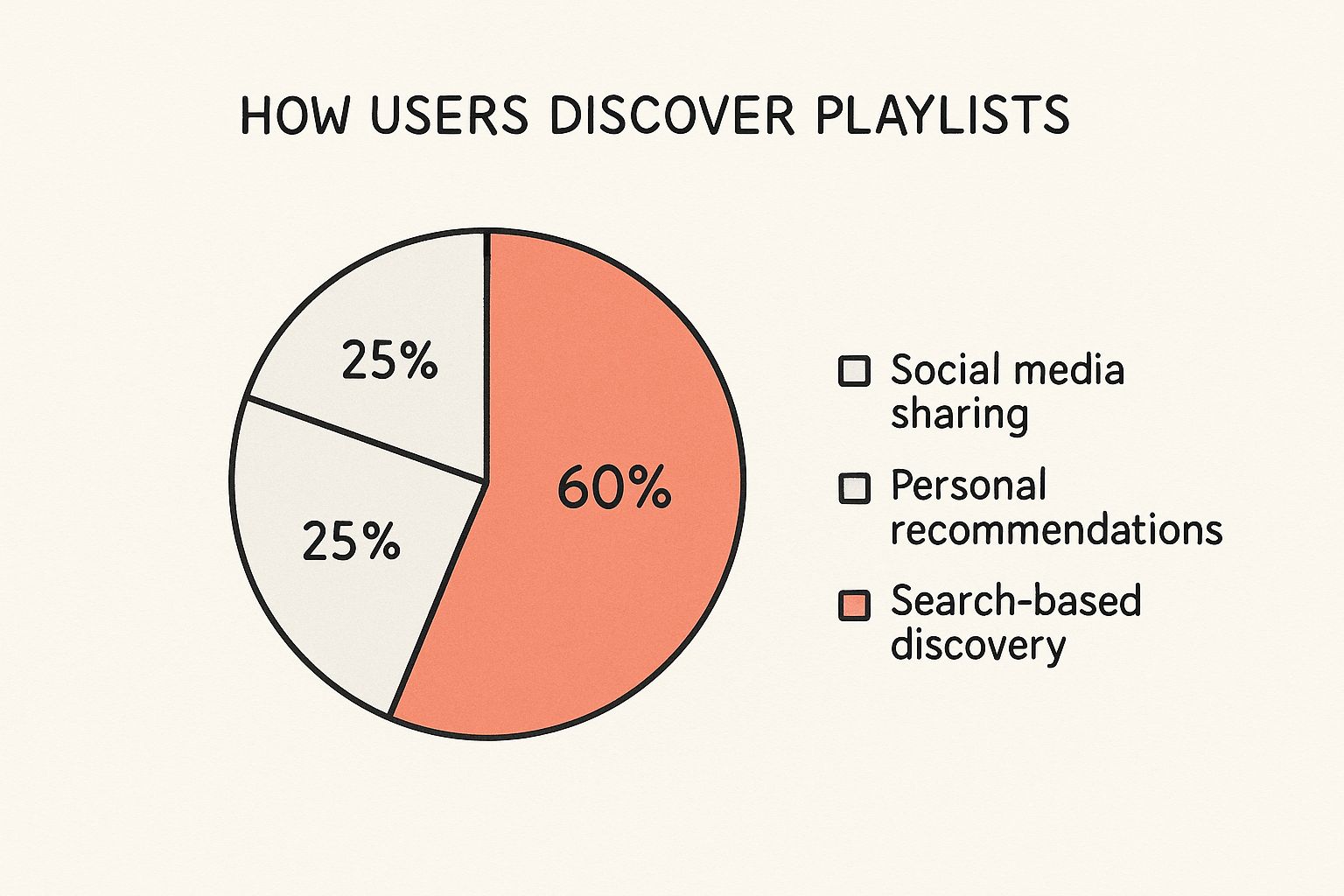Spotify Playlist SEO Tips to Boost Visibility
- Aaron Whittington

- May 21
- 13 min read
Cracking Spotify's Search Algorithm

Successfully optimizing your Spotify playlists requires understanding the platform's search algorithm. Unlike search engines like Google, Spotify offers limited public data. This makes understanding its search mechanics a challenge. However, analyzing available data and observing successful playlist curators provides valuable clues. General SEO strategies for static websites can offer helpful insights, even though Spotify is a dynamic service.
Key Factors in Spotify Playlist SEO
Spotify's algorithm considers various factors when ranking playlists. These go beyond simply including relevant keywords.
Curation: What tracks you include matters more than anything else. You must curate a playlist that encourages the longest possible listen time and appeals to the highest percentage of listeners in your target niche. The top 10 songs are the most important.
Playlist Title: The title is the first impression. Use a short, catchy title. Include a relevant, high-volume keyword that users would actually search for. Think about natural listener search terms.
Playlist Description: This space allows for longer-tail keywords. For example, if your title is "Workout Motivation," the description might include "best gym tracks," "upbeat workout music," or "pop hits for exercise."
Cover Art: Visual appeal matters. Your cover art needs to be eye-catching. It should stand out from the competition. Experiment with different colors and designs to find what works for your audience.
Metrics like follower growth, engagement (saves, shares, and listens), and track popularity are also likely factors in Spotify's search algorithm. Understanding how to leverage these is crucial for successful Spotify Playlist SEO.
Leveraging Available Data
Two key resources provide useful data: artist.tools and PlaylistRankings. artist.tools offers a wealth of information. This includes Growth Rate, showing how quickly playlists grow for specific keywords, and Total Followers, revealing the combined follower count of the top 50 playlists for a keyword. This helps gauge the competitive landscape. PlaylistRankings offers similar data, though artist.tools often provides more comprehensive and faster insights.
Spotify's user base offers a significant opportunity. With 640 million monthly active users and 252 million premium subscribers, effective Spotify SEO can dramatically increase a playlist's reach. More detailed statistics can be found here. This underscores the importance of strategic keyword selection and optimization. A well-optimized playlist could attract listeners from popular playlists like Today's Top Hits, which boasts over 34 million followers. This potential highlights the impact of strong Spotify playlist SEO.
Finding Your Keyword Sweet Spot
Discovering the right keywords for your Spotify playlists can feel like navigating a dense jungle. Unlike Google, which offers readily available keyword data, Spotify keeps its search information private. This presents a unique challenge for playlist SEO. A strategic, data-driven approach is essential for success.

This infographic illustrates how users discover playlists. A significant 60% find playlists through search, highlighting the importance of optimizing your playlists for discoverability. For more tips and tools, check out this helpful resource: How to find Spotify playlists - Top tips & tools.
Understanding the Data Landscape
Thankfully, tools like artist.tools and PlaylistRankings provide valuable data to inform your keyword strategy. While both offer helpful insights, artist.tools is generally preferred for its comprehensive data and frequent updates.
Understanding how search algorithms work is also vital. This article on the Twitter Algorithm provides a good overview of core algorithm principles.
Key metrics like Growth Rate and Total Followers, offered by artist.tools, provide a snapshot of keyword performance. Growth Rate shows how quickly playlists are gaining followers for a specific keyword. Total Followers represents the combined follower count of the top 50 playlists for a given keyword, indicating the level of competition.
Balancing Broad and Niche Keywords
Effective Spotify playlist SEO involves balancing short-tail and long-tail keywords. Your playlist title should ideally include a short-tail, high-volume keyword., with a bit of spice (like an emoji, or the year). These have to be common terms users might type directly into Spotify's search bar, like "gym songs" or "rnb playlist". These broader keywords attract a larger audience and are your "primary" keyword.
Long-tail keywords, used in your playlist description, target specific listener segments. An ongoing theory is that the content in your description can be used in any order. So, generally, repeating keywords is often a waste of character space.
For example, a "Workout Music" playlist might have a description like:
best gym songs for cardio, top workout motivation music, hype fitness playlist
Notice how we didn't repeat any keywords? This combination increases visibility in both broad and niche searches.
Competitive Analysis for Keyword Opportunities
Analyzing competitor playlists is crucial for uncovering untapped keyword opportunities. By examining their keyword usage, you can identify niches they might be missing. This allows you to create tailored playlists for specific listener groups.
For instance, noticing a lack of playlists focused on "indie folk music for road trips" presents an opportunity. Creating a playlist targeting this specific long-tail keyword can help you stand out and attract a dedicated audience.
This strategy mirrors traditional SEO, where understanding competitive gaps is key to ranking success. To illustrate the differences and similarities between the tools available, let's look at a comparison table:
To help you choose the right tool for your needs, the following table compares the key features of artist.tools and PlaylistRankings:
Spotify Keyword Research Tools Comparison
A comparison of the two main tools available for Spotify keyword research, highlighting their features, pricing, and data metrics
This table highlights the strengths and weaknesses of each tool, allowing you to make an informed decision based on your budget and data needs. artist.tools offers more comprehensive data and faster updates but comes out slightly more expensive, and has a larger technical learning curve.
By spotting keyword opportunities, analyzing the competition, and strategically selecting keywords, you can dramatically improve your playlist's discoverability and attract a larger audience on Spotify.
Crafting Titles That Rank and Resonate
Your playlist title is one of the most important elements for Spotify playlist SEO. It's the first thing potential listeners see in search results. It plays a crucial role in attracting clicks. Think of your title as the storefront of your playlist. A compelling title draws listeners in, while a bland one doesn't. This section explores creating titles that rank well in Spotify’s search algorithm and resonate with your target audience.
The Power of Keywords
Just like traditional SEO, keywords are essential for Spotify playlist SEO. However, on Spotify, publicly available data is limited. Your primary keyword, a short-tail high-volume term, should be in your title. This should be something someone would actually type into Spotify search. For example, if your playlist is for gym workouts, using "Workout Music" as your primary keyword will increase visibility.
Beyond the Primary Keyword
While your title should feature your main keyword, avoid stuffing it with irrelevant terms. Instead, create a title that is descriptive and engaging. Consider your target audience’s emotions and needs. What are they looking for in a playlist? Do they want to feel energized, relaxed, or nostalgic? Incorporating these emotional cues into your title can make it more appealing.
Optimizing for Search and Emotion
Effective Spotify playlist titles balance SEO and listener appeal. For instance, instead of just "Indie Pop" try "happy indie pop 2025". This title still includes the primary keyword but adds an emotional element. It also considers that "indie pop" is highly competitive, so we add in "happy" to additionally optimize for a longer-tail keyword "happy indie pop".
Examples and Pitfalls
Consider these examples of title optimization:
Before: "Hip Hop/Rap Hits"
After: "hype rap mix | hip hop 2025"
The improved title keeps the keywords "hip hop" and "rap" but adds imagery and clarifies the playlist's purpose.
Another example:
Before: "Party Music"
After: "SUMMER PARTY MIX 🎉 DANCE POP 2025"
The optimized title keeps "Party Music" but adds "dance", "summer", and "pop" for broader appeal and a compelling description.
A critical factor in Spotify playlist SEO is track popularity. Spotify's algorithm considers the popularity of the tracks when determining search rankings. Playlists with popular artists, like Arijit Singh, with over 132.4 million followers, can boost visibility. Furthermore, 70% of Spotify's top 20 most-followed playlists primarily contain new releases. This indicates the importance of new music. Find more detailed statistics here. However, simply filling your playlist with popular tracks isn’t enough; they must also be relevant to your title and description, and flow in a way that keeps the listener engaged.
Create Engaging Curation
The selection of songs you include in a playlist is crucial. Your playlist should be highly relevant to its theme, provide a seamless transition from one track to the next, and consist of songs with significant popularity. You can assess the popularity of tracks using metrics available on artist.tools.
To enhance your playlist, examine the top 10 songs featured in the highest-ranking playlists within your genre. Begin by incorporating these tracks, then work on enhancing the flow and overall appeal. Constructing a playlist with these top 10 songs can be an effective strategy for creating a playlist that attracts high engagement, as playlists with poor-performing top 10 songs typically do not achieve high rankings.

Testing and Iteration
Finally, experiment with different title formulations. Use A/B testing to track which titles perform best. Analyze which titles attract the most clicks and followers. This data-driven approach will help refine your titles over time and maximize their impact. By carefully crafting titles that are both keyword-rich and emotionally resonant, you can significantly improve your chances of attracting listeners on Spotify.
Optimizing Descriptions for Search and Conversion
Your playlist description on Spotify is valuable space. It’s a chance to draw in both the algorithm and potential new listeners. It’s more than just a tracklist; it's where you tell a story, connect with your audience, and boost your Spotify playlist SEO. This means your descriptions need to inform and engage.
Keyword Integration for Discoverability
Good SEO strategy means using relevant keywords in your playlist description. But Spotify’s algorithm is different from a regular search engine. Because public data is limited, tools like artist.tools become important. This platform provides data on keyword Growth Rate and Total Followers, helping you choose the right terms. Your playlist title is your main keyword. Use the description to expand on those themes with related long-tail keywords.
For example, if your playlist title is "Chill Vibes," your description might include long-tail keywords like "relaxing music for studying," "calm background music for work," or "acoustic indie for unwinding." This helps you reach a wider audience and target what listeners are actually looking for.
Communicating Value and Building Trust
Keywords are important for the algorithm, but your description also needs to connect with real people. This means showing the playlist's unique value. What makes your playlist different? Who is it for? What kind of experience does it offer? Answering these questions creates a compelling story that attracts followers.
Think of your description as a short pitch. You're selling the experience your playlist offers. A clear and engaging description builds trust and encourages listeners to follow you.
Description Templates for Different Playlist Types
Here are some templates you can adapt:
Mood-Based: "Escape the everyday with calming acoustic tracks. Perfect for unwinding after a long day, studying, or quiet moments. Featuring indie folk, ambient soundscapes, and mellow instrumentals."
Genre-Specific: "Dive into the world of deep house with this energetic playlist. Featuring established artists and rising stars, this collection delivers a non-stop mix of energetic beats, hypnotic rhythms, and euphoric melodies, ideal for the dancefloor or a late-night drive."
Activity-Based: "Fuel your workout with this high-energy mix of motivational rock anthems, upbeat pop hits, and electronic tracks. Designed to keep you moving, this playlist is perfect for the gym, running, or anything that needs an extra boost."
Analyzing High-Performing Descriptions
Study the descriptions of successful playlists similar to yours. What kind of language do they use? How do they use keywords? What is their overall tone and style? This research can teach you a lot.
Best Practices for Spotify Playlist Descriptions
Keep it concise: Spotify shortens long descriptions, so be direct.
Use strong calls to action: Encourage listeners to follow.
Update regularly: Fresh descriptions show you’re active and can improve SEO.
Be authentic: Let your personality show.
Test and iterate: Experiment and use artist.tools to see what works best.
Combining keyword optimization with compelling storytelling makes your descriptions powerful. They’ll attract the Spotify algorithm and build a loyal audience. You can't control every aspect of Spotify’s search algorithm, but optimizing your descriptions is key to boosting your playlist’s visibility and ensuring its long-term success.
Visual Optimization: Cover Art That Captures Clicks
In the crowded world of Spotify, your playlist cover art is the first thing potential listeners see. It's the face of your curated collection, and like a storefront, it needs to attract attention and encourage clicks. This section explores the design principles behind effective playlist covers, helping you turn casual browsers into loyal followers.

Understanding The Visual Landscape
Imagine Spotify's search results as a vast digital music library. Users scroll through countless playlists, each displayed with its cover art. Your cover has to stand out. Effective Spotify playlist SEO involves more than keywords; it's about visually connecting with your audience. This means creating art that is both attractive and informative, even at a small size.
Color Psychology and Dark Mode
Spotify primarily uses dark mode. This significantly impacts cover art design. Bright, vibrant colors pop against the dark background, grabbing attention more effectively than muted colors. Color psychology also plays a role. A playlist titled "Chill Vibes" might use cool blues and greens, while a "Workout Motivation" playlist might use energetic reds and oranges.
Typography and Visual Hierarchy
Your cover art's typography is just as important as your playlist title. Choose fonts that are easy to read at small sizes. Use visual hierarchy, making the playlist title the most prominent element. A secondary font can be used for subheadings or descriptions. A clear visual hierarchy lets users instantly grasp the playlist's theme.
Simplicity and Contrast
Avoid cluttering your cover art. Simplicity creates a stronger impact at thumbnail size. Focus on a single striking image or graphic. Maintain high contrast between the foreground and background. This ensures your title remains readable even when small.
Brand Consistency For Curator Profiles
If you manage multiple playlists, brand consistency is key. Using consistent color palettes, fonts, and graphic styles builds recognition and strengthens your brand. This makes your playlists easily recognizable in search results, building trust and encouraging more followers.
Tools and Resources
Creating professional cover art doesn't require advanced design skills. Canva offers pre-made templates and easy-to-use design tools. Experiment with different styles to create visually appealing cover art that supports your Spotify playlist SEO. Artist.tools can help you track your playlist's performance after optimizing the visuals. By monitoring playlist growth, you can refine your visual strategy and learn what attracts listeners. Combining data and design creates captivating playlist covers that stand out from the competition.
Performance Analytics: Measuring What Matters
Beyond simply creating a Spotify playlist, optimizing its performance is key. This involves moving past surface-level metrics like follower counts and delving into the data that truly drives Spotify playlist SEO. Data-savvy curators use these insights, gleaned from the limited analytics available, to inform their optimization strategies. Let's explore how you can use these insights to your advantage.
Interpreting Key Metrics
While Spotify isn't as transparent with data as other search engines, resources like artist.tools and PlaylistRankings offer valuable metrics. You might find this article interesting: Why Spotify Playlists Are Important. These tools allow you to track vital statistics that can shape your SEO strategy.
For instance, Growth Rate, available on artist.tools, shows how quickly playlists are gaining followers for a given keyword. A high growth rate suggests strong listener interest and potential for your playlist to take off. Knowing the Total Followers of the top 50 playlists for a specific keyword also illuminates the competitive landscape. This metric helps you assess the competition and spot potential opportunities.
Implementing A/B Testing
A/B testing is a powerful optimization technique for various playlist elements. It involves creating two slightly different versions (A and B) of an element, such as the title or description, and comparing their performance. It's like a small experiment to see which version resonates more with your audience.
Title A/B Testing: Experiment with different titles, using various keywords and emotional cues. Compare "Workout Music" with "Workout Motivation: Upbeat Gym Hits" to see which attracts more clicks.
Description A/B Testing: Test different descriptions by varying the length, keyword density, and call to action to find the most effective approach. artist.tools can help track each version’s performance.
Cover Art A/B Testing: Even small changes to your cover art can have a big impact. Test different colors, fonts, and imagery to see which visuals grab attention and boost clicks and follows.
Documenting Changes and Correlating with Performance Shifts
Systematic documentation maximizes the benefits of A/B testing. Use a spreadsheet or document to track changes to your playlist title, description, and cover art. Record the corresponding performance metrics alongside these changes.
This allows you to directly correlate modifications with performance shifts, identifying which optimizations are most effective. For example, if a title change significantly increases followers, you've found a winning formula.
The following table summarizes key metrics to track for your playlists:
Key Spotify SEO Metrics to TrackEssential metrics for evaluating the performance of your playlist SEO efforts and making data-driven optimizations
This table provides a framework for tracking and analyzing key metrics for your playlist's success. Aim for continuous improvement across all metrics.
This data-driven approach allows you to continually refine your Spotify playlist SEO strategy. By consistently analyzing, testing, and adapting, you can maximize your playlist’s visibility and achieve sustainable growth. This commitment to continuous improvement is what sets successful curators apart.
Building Sustainable Playlist Growth
Successfully optimizing your Spotify playlist for initial visibility is a significant first step. But the real work lies in maintaining and growing that momentum. This means building a sustainable presence that continually attracts listeners. Think long-term growth, not just short-term gains.
Content Freshness and Listener Engagement
Keeping your playlist fresh is crucial for both the Spotify algorithm and listener satisfaction. Regular updates with relevant new releases keep your content current and engaging. This signals to Spotify that your playlist is active and caters to evolving tastes. It also gives your followers a reason to return. For example, a "Pop Hits" playlist should feature the latest chart-toppers, while a "Chill Vibes" playlist might benefit from new mellow tracks.
Cross-Promotion and Network Building
Even a small existing network can significantly expand your playlist’s reach. Cross-promoting on platforms like Instagram or Twitter exposes your playlist to a wider audience. Collaborating with other playlist curators offers mutual benefits. This could involve featuring each other's playlists or co-curating special editions. It’s a partnership where everyone gains exposure to new listener bases.
Check out our guide on getting your music on Spotify playlists for additional strategies.
Building Curator Authority
Establishing yourself as a tastemaker in a specific niche is a powerful long-term strategy. This requires understanding your target audience and consistently delivering content they love. Focusing on a genre like "Indie Electronic" or a mood like "Focus Music" positions your playlist as the go-to source for listeners with those tastes. This focused approach builds engagement and loyalty, boosting your playlist’s visibility.
Strategic Partnerships and Artist Collaboration
Direct artist collaboration significantly expands playlist reach. Featuring up-and-coming artists introduces your followers to new music while offering emerging talent valuable exposure. It's a win-win: you get fresh content, and artists get increased visibility. Artists are then likely to share your playlist, creating a natural amplification effect.
Adapting to Spotify's Evolving Ecosystem
Spotify constantly evolves. Keeping up with algorithmic changes and adapting your strategies is crucial. Tools like artist.tools provide insights into Growth Rate and Total Followers, helping you stay ahead. These metrics allow you to adjust keywords, content, and overall strategy based on current trends. This proactive approach maintains visibility and attracts followers amidst ongoing algorithm changes.
By focusing on these strategies, you can build a playlist that not only attracts listeners but keeps them coming back. This sustainable approach ensures long-term visibility and establishes your presence within the dynamic Spotify ecosystem.
Ready to take your Spotify playlist to the next level? Discover powerful tools and insights with artist.tools and unlock your playlist's full growth potential.

It actually reminds me a lot of training, where consistency and smart strategy lead to results over time. Just like a playlist grows with the right effort, progress in fitness also depends on discipline and proper support. That’s one of the reasons I’ve looked into options like Buy injectable steroids at pharma-grade, since building strength and endurance effectively often requires more than just hard work, it also takes the right tools to reach peak performance.